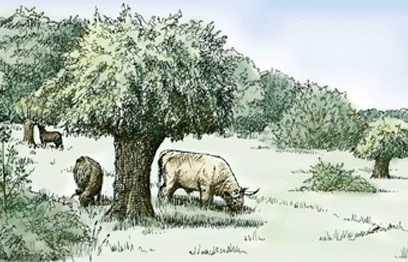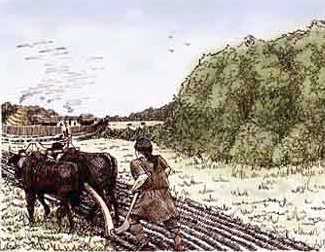Farming History - introduction
|  |
A short history of farming
Farming not only produces the food we eat, it created the
countryside we live in and is changing it, even as you read these
words. The classic British landscape of small fields, farms and
villages linked by sunken lanes was carved out of the Wildwood which once
covered much of Britain by people earning a living from the land, first by
hunting and then by farming. How did this happen?
 As the ice retreated north at the end of the most recent
glaciation, 15,000 years ago, it left behind a landscape of tundra and
rock. At this time the North Sea did not exist: plants, animals and people
could travel on dry land from mainland Europe to Britain. Trees moved north
across this land bridge and, as the climate warmed, a forest spread over
much of lowland Britain. Deer, elk, aurochs (the wild ox, ancestor of
domestic cattle), wolves and other animals followed the trees, and
groups of Mesolithic hunters followed their quarry into Britain.
As the ice retreated north at the end of the most recent
glaciation, 15,000 years ago, it left behind a landscape of tundra and
rock. At this time the North Sea did not exist: plants, animals and people
could travel on dry land from mainland Europe to Britain. Trees moved north
across this land bridge and, as the climate warmed, a forest spread over
much of lowland Britain. Deer, elk, aurochs (the wild ox, ancestor of
domestic cattle), wolves and other animals followed the trees, and
groups of Mesolithic hunters followed their quarry into Britain.  These hunters began the long process
of clearing the forest by using flint axes and fire to create grassy
clearings in which deer and other grazing animals would come to feed.
(There is evidence that upland peat moors such as the Yorkshire Moors
formed after these clearances, nearly 10,000 years ago.) Their movements
across the landscape established tracks and routes such as the Icknield
Way.
These hunters began the long process
of clearing the forest by using flint axes and fire to create grassy
clearings in which deer and other grazing animals would come to feed.
(There is evidence that upland peat moors such as the Yorkshire Moors
formed after these clearances, nearly 10,000 years ago.) Their movements
across the landscape established tracks and routes such as the Icknield
Way.
The idea of Agriculture and the technology needed to keep domestic
animals and to plant, harvest and process crops spread slowly north
and west across Europe from Greece, reaching the coast of France and
Belgium about 6,000 years ago. The first signs of farming in Britain
soon appeared, ranging from the the seeds of emmer and einkhorn
wheats and barley to the marks left by an ard (the first plough) and
the stone querns on which grain was ground to flour. It would have
been relatively easy to cultivate the areas of grassland which had
been grazed by deer and other wild game, but more land was always
needed as yields fell without fertilisers and the population grew.
Sharp polished stone axes felled trees faster than flint, and the
surrounding undergrowth was burnt or browsed to death by livestock
and wild game. Crops were grown for a few years on the new fields
then, when yields dropped, the farmers moved on to clear more of the
forest. Grazing animals prevented the forest reclaiming the old
fields while their droppings fertilised the soil; early farmers would
soon have learned the value of manure and the need to rest fields as
fallow to recover fertility.
 More food meant
more people could live in the same place for longer, so settlements formed.
Permanent boundaries marking land holdings first appeared in the Bronze
Age, 4,000 years ago. In the Iron Age people were living in permanent
houses, farming land divided into fields and storing their harvest for use
through the year. By the time the Romans arrived, large parts of southeast
England were already a patchwork of hedged fields, with farmsteads and
villages connected by tracks and droveways.
More food meant
more people could live in the same place for longer, so settlements formed.
Permanent boundaries marking land holdings first appeared in the Bronze
Age, 4,000 years ago. In the Iron Age people were living in permanent
houses, farming land divided into fields and storing their harvest for use
through the year. By the time the Romans arrived, large parts of southeast
England were already a patchwork of hedged fields, with farmsteads and
villages connected by tracks and droveways.
Sarah Wroot 2000

 As the ice retreated north at the end of the most recent
glaciation, 15,000 years ago, it left behind a landscape of tundra and
rock. At this time the North Sea did not exist: plants, animals and people
could travel on dry land from mainland Europe to Britain. Trees moved north
across this land bridge and, as the climate warmed, a forest spread over
much of lowland Britain. Deer, elk, aurochs (the wild ox, ancestor of
domestic cattle), wolves and other animals followed the trees, and
groups of Mesolithic hunters followed their quarry into Britain.
As the ice retreated north at the end of the most recent
glaciation, 15,000 years ago, it left behind a landscape of tundra and
rock. At this time the North Sea did not exist: plants, animals and people
could travel on dry land from mainland Europe to Britain. Trees moved north
across this land bridge and, as the climate warmed, a forest spread over
much of lowland Britain. Deer, elk, aurochs (the wild ox, ancestor of
domestic cattle), wolves and other animals followed the trees, and
groups of Mesolithic hunters followed their quarry into Britain.  These hunters began the long process
of clearing the forest by using flint axes and fire to create grassy
clearings in which deer and other grazing animals would come to feed.
(There is evidence that upland peat moors such as the Yorkshire Moors
formed after these clearances, nearly 10,000 years ago.) Their movements
across the landscape established tracks and routes such as the Icknield
Way.
These hunters began the long process
of clearing the forest by using flint axes and fire to create grassy
clearings in which deer and other grazing animals would come to feed.
(There is evidence that upland peat moors such as the Yorkshire Moors
formed after these clearances, nearly 10,000 years ago.) Their movements
across the landscape established tracks and routes such as the Icknield
Way.
 More food meant
more people could live in the same place for longer, so settlements formed.
Permanent boundaries marking land holdings first appeared in the Bronze
Age, 4,000 years ago. In the Iron Age people were living in permanent
houses, farming land divided into fields and storing their harvest for use
through the year. By the time the Romans arrived, large parts of southeast
England were already a patchwork of hedged fields, with farmsteads and
villages connected by tracks and droveways.
More food meant
more people could live in the same place for longer, so settlements formed.
Permanent boundaries marking land holdings first appeared in the Bronze
Age, 4,000 years ago. In the Iron Age people were living in permanent
houses, farming land divided into fields and storing their harvest for use
through the year. By the time the Romans arrived, large parts of southeast
England were already a patchwork of hedged fields, with farmsteads and
villages connected by tracks and droveways.